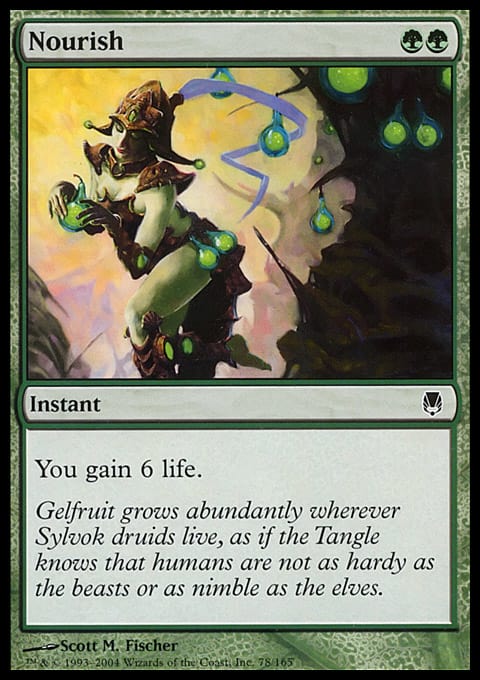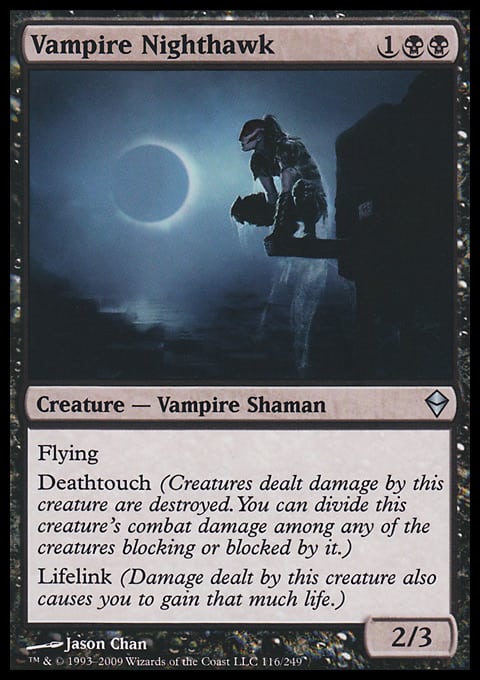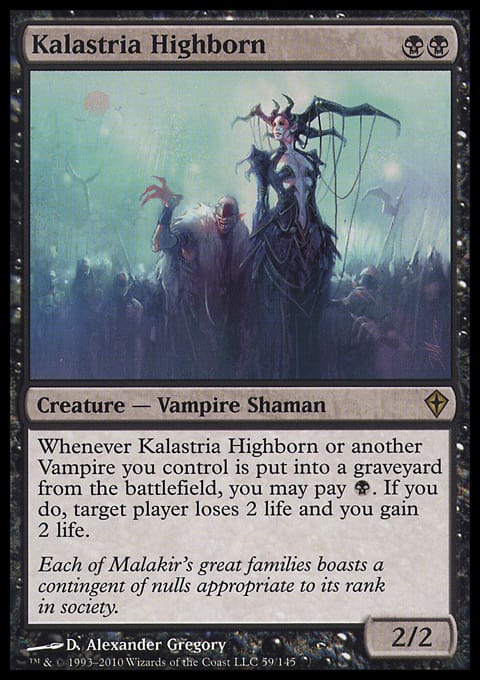Before I get started, I want to mention that I did write an extended comment on Friday for my article last week. For those of you who are interested, it’s there. I would ask that you refrain from discussing that article in the comments for this article, however.
Now, on to this week’s subject: the Philosophy of Fire. For those of you who haven’t read the original Flores article, here it is. This week, I want to look a little more in detail at the principle of the Philosophy of Fire and analyze what I feel to be its primary strategic weakness. Zvi also has a solid article on it here.
The principle of the Philosophy of Fire is the trading of life for cards and the efficiency of those trades. What I want to look at here is the inherent strategic weakness this gives the Philosophy of Fire decks and the implications of that weakness on the design and application of cards such as Timely Reinforcements, Kitchen Finks, Pulse of the Fields, and Obstinate Baloth. In the first section, I’ll discuss the strategic principles and properties associated with accepting the Philosophy of Fire. In the second, I will talk about the defender’s advantage this confers on your opponent. Finally I will discuss the practical applications and impact on design this has.
Examining the Philosophy of Fire
I want to begin with an illustrative graph:

This graph is for strictly illustrative purposes; there are no hard numbers behind it, and it is not designed to be precise. What this graph does is illustrate (roughly) the value and effectiveness of the individual cards each type of deck possesses over the course of the game. This demonstrates the primary fundamental weakness of decks trying to use the Philosophy of Fire as an operational principle—they cede all long-game control over how the game flows.
Why is this the case? Why is it that decks that follow the Philosophy of Fire become less effective as time goes on?
The answer lies in the construction of Philosophy of Fire decks. The primary focus of any Philosophy of Fire deck is to trade cards for a specific resource (generally life). The deck needs to make this trade with great frequency, and thus, by nature, it needs to be highly redundant.
As a Magic game goes longer, there is both an increased ability and need for interaction on a variety of fronts. This is exactly counter to what the Philosophy of Fire deck wants to do. The Philosophy of Fire deck seeks to make the same trade over and over again, and so it focuses its attempts to that end. By necessity, it neglects other strategic avenues—otherwise, it would not be able to accomplish its primary goal with such brutal efficiency. Because it neglects these other strategic avenues, the Philosophy of Fire deck invariably ends up in a position in which it is dealing with a threat it is not well equipped to handle later in the game.
In contrast, slower strategies like Rock or control often have the ability to deal with late-game threats. The Rock deck focuses on generating incremental advantage over a large number of trades, so its individual card efficiency levels off, but it still remains reasonably powerful. Control is designed to play cards that scale in power over time, allowing it to present extremely powerful end games with huge haymakers. Tron decks in Modern are a great example of this sort of principle. The strength of Tron is in its endgame of Eldrazi and an Iona–Mindslaver lock, which is essentially unbeatable if you allow the Tron player to reach that point.
Trading Resources and Defender’s Advantage
The most basic execution of the Philosophy of Fire is the forty–Lightning Bolts–plus-lands deck. While this is practically underpowered, from a strategic standpoint, it serves as a good example to examine how The Philosophy of Fire interacts with resource trading. Thus, consider the deck with Lightning Bolts. Now consider what happens if the player of that deck puts you to 14 with a pair of Bolts on his first two turns, and then you play this card:
So, what has Nourish bought you in this situation? Well, in order to bring you back to 14 (the state you were in previously), the forty-Bolt player must expend two more Bolts (played on his next turn) to get there again, thus, the Nourish has bought you those two Bolts. This much is evident. But, what the Nourish has also bought you in this situation is your next land drop. I talked about this when I talked about controlling game flow and the effect of Explore, and it shows up again here. If you go refer to the graph above, you can see why this is so incredibly powerful. What you are doing is not only gaining card advantage (trading one of your cards for two of his), but you are also accelerating the game to a situation in which his cards are of minimal effectiveness.
This basic principle of buying time is absolutely crucial to how the Philosophy of Fire interacts with resource trades. Because the timing of the game is working against the Philosophy of Fire deck, the ability to gain not only cards, but also time, by defending your life total is a huge contributor of the strategic weakness of decks of this nature. The huge time cost associated with undoing defensive cards like Nourish is, in fact, the more important effect.
Essentially, this confers upon your opponent a massive defender’s advantage. Because your deck is predictable (due to its redundant nature, it has to attack the opponent in a specific way), blunting those lines of attack becomes relatively easy. As long as the card pool facilitates it, the cards will be found and played that can effectively deflect whatever the Philosophy of Fire deck can muster. Due to the linear nature of the deck, its threat selection is restricted, and thus, any deck defending against it only has to worry about a small subset of cards. This is the first portion of the defender’s advantage.
The second portion of this defender’s advantage is the time effect I pointed out earlier. Because the defender can select when he positions these spells, he controls when he receives that extra time. In effect, the opponent gains cheap Time Walks and Time Stretches that he can play at various points.
The big thing is that each deck has its own defensive deck speed. Each deck begins to operate well from a proactive standpoint at a different place in time as well. By understanding the shape of the operational curve of your deck, you can position your Time Walk in such a way as to jump you directly to the point at which you begin to do your thing. This is particularly powerful because it begins to force the Philosophy of Fire deck into a defensive position—one which it is generally not prepared for.
Looking at Card Design
Now take a look at these cards:
Let’s take a look at the first row of cards: the dedicated hosers. These are cards that are specifically strong against Philosophy of Fire decks and are not generally good elsewhere. The problem with these cards is that they are extremely effective and create an issue because of the nature of sideboarding. These cards can exert influence on a format simply by existing. In much the same way that Dredge can be kept down by the mere presence of sideboard options, decks that operate according to the Philosophy of Fire can be kept down by the presence of sideboard options as well. The fact that cards like Timely Reinforcements are useful elsewhere causes collateral damage only exacerbates the issue.
Cards like Timely Reinforcements, Kor Firewalker, and Pulse of the Fields are cards that I wish Wizards would refrain from printing in most formats. It’s not that it’s never okay to print these cards, but they do have a substantially greater influence on the format than they have any right to because of their presence as sideboard options.
So, what’s the problem with keeping Philosophy of Fire decks down? The problem lies in format balance. The purpose of the Philosophy of Fire is to keep formats honest. Because decks that operate on this principle are focused solely on generating a specific trades and producing velocity, they act as a clock of sorts for the format. They keep decks honest by forcing decks to interact with them in a meaningful manner early in the game. Without this check, players essentially gain the ability to do whatever they want. While this sounds like fun (and sometimes is), this can easily lend itself to an imbalanced format.
The issue is that the Philosophy of Fire is a fundamentally underpowered strategy because of its strategic weakness. The fact that it cedes all long-game control is a huge hole that is actually relatively easy to exploit simply because all exploiting it entails is maintaining the current game state (both players draw a card and maybe make a land drop), a goal which is achievable for the vast majority of, if not all, strategies.
Due to the underpowered nature of the strategy, dedicated hosers are simply not necessary. GrizzlyBears.dec is also an underpowered strategy, but no one has any intentions of ever printing dedicated Grizzly Bears hosers. While the Philosophy of Fire is more powerful than GrizzlyBears.dec, it is still underpowered enough that its strategic weaknesses can be exploited without much effort.
Thus, in order for Philosophy of Fire decks to be relevant at all, one of three things must happen: They must be sufficiently powerful to overwhelm their dedicated hosers early, they must have the ability to sidestep their hosers in a manner that is still conducive to trading efficiently in their primary game plan, or the hosers must not exist. The first is difficult because of power-balancing issues. You could put a 1-mana 5/5 in red, but it would make games unnecessarily swingy and imbalance the format to the point that it becomes largely based on variance.
The second is hard because of the inherent design limitations associated with creating cards that fulfill that role (there are only so many Sulfuric Vortexes you can print). On top of this, there is no guarantee that your sidestepping method is effective. The modern example of this is Shrine of Burning Rage versus Timely Reinforcements. In the absence of both cards, a reasonable Philosophy of Fire deck would almost certainly exist. Thus, from a design standpoint, if you add a hoser, adding a sidestepper would work. The hoser is Timely Reinforcements, and the sidestepper is Shrine of Burning Rage, but as you can see, Timely Reinforcements has clearly been more effective. In some cases (Sulfuric Vortex), your sidestepper will work; however, in other cases, it just won’t matter. Therefore, in truth, the easiest thing to do is the third option.
As you can see, Pulse of the Fields, Kor Firewalker, and Timely Reinforcements can exert a disproportionately strong influence on formats while not seeing play. It’s fine to define a format because you are played in every deck all over the place. It’s not fine to define a format from the bench of ten percent of the decks in question.
So, what’s the solution then? How do we give players the tools to interact and deflect attacks based on the Philosophy of Fire? The answer lies in the second row of cards. What’s fundamentally different about Vampire Nighthawk, Kalastria Highborn, and Kitchen Finks?
These cards advance game plans proactively.
Power levels aside, all of these cards are useful in a proactive sense. Even if they aren’t having the additional value of deflecting Philosophy of Fire–based assaults, they are still solid cards. This means that they have the ability to be played in decks that would otherwise want them anyway. In essence, having the ability to deflect an assault based on the Philosophy of Fire is gravy. It’s not the primary focus of the card, but in the event a situation arises, this ability adds to the strength of the card.
Remember that the primary purpose is not to invalidate the Philosophy of Fire as a strategy, but to ensure that it is not overpowered. The problem with cards like Timely Reinforcements and Kor Firewalker are that they are actually too efficient at checking the Philosophy of Fire. They are designed to do so and accomplish this purpose well, but due to the inherent strategic weakness of the Philosophy of Fire, nerfing it is not a necessary design goal.
Kitchen Finks is also too powerful, but not because it is approached from an incorrect design standpoint. The card is too powerful simply based on efficiency. The effect it provides for mana is very far above the power curve. A card like Obstinate Baloth comes from the same design mold and is much more appropriately costed.
In the end, I feel that designing hosers for the Philosophy of Fire is a mistake because the strategy hoses itself. By ceding all long-game control, a deck using the Philosophy of Fire confers a huge defender’s advantage to the opponent simply through its fundamental strategic selection. Sure, often cards can mitigate this (Knight of the Reliquary and Shrine of Burning Rage are good examples), but that still doesn’t change the fact that the deck has a hole in its core strategy. This hole can be exploited by other decks in an efficient manner through cards that can help them otherwise. The hole doesn’t need to be targeted.
Chingsung Chang
Conelead most everywhere and on MTGO
Khan32k5 at gmail dot com


























